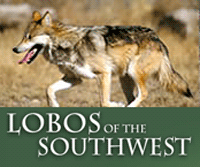Arizona Daily Sun (Original) Posted on July 25, 2014 by Eric Betz
The U.S. Fish and Wildlife Service is scrapping any immediate plans to allow the beleaguered Mexican gray wolf population to expand north to the Grand Canyon, as many wolf advocates and scientists have advocated in recent years.
But wolves could still roam as far north as Flagstaff, so long as they didn't cross Interstate 40.
On Thursday, the federal government published its long-awaited draft environmental impact statement, as well as revisions to proposed rule changes for the wolf population in Arizona and New Mexico. Depending on the final plan, it could be the most significant change for the Mexican gray wolf since being reintroduced to the wild following their extermination.
The proposal drastically expands the potential wolf habitat beyond its current small range along the New Mexico-Arizona border, where the animal has been limited since 1998. Under most alternatives in the proposed plan, wolves would be able to roam in New Mexico and Arizona from Interstate 40 south to the border of Mexico.
Wolves wandering north to habitat on the San Francisco Peaks or Grand Canyon National Park and beyond would be removed.
Originally, the proposed rule changes announced by Fish and Wildlife last summer would have set the wolf's southern boundary at Interstate 10. The agency decided to expand the boundary all the way down to Mexico because that country's government has started its own reintroduction plan in recent years. Last week, Mexico announced the first wild-born lobo pups seen in decades.
STOPGAP MEASURE
Wolves will often roam vast distances in search of food and mates. That makes it increasingly likely that the animals will cross the border and end up in southern Arizona and New Mexico.
But Fish and Wildlife says that this plan is only a stopgap measure, legally mandated after settling a lawsuit with the Center for Biological Diversity.
Once the environmental impact statement process is completed, federal scientists will immediately get back to work on a plan for long-term recovery of the wolf. That long term plan is expected to be released within the next two to three years, according to the Fish and Wildlife Service.
"You have to keep in mind what our objective is right now, which is an interim step toward conservation and recovery of the Mexican gray wolf," said Tracy Melbihess of the federal Mexican Wolf Recovery Program. "We have not yet determined what the big picture is for the Mexican gray wolf. We know it's going to probably entail several populations spread over a large geographical area."
Instead, the current goal is to build up the population from its current core in the Blue Range. The species will keep its experimental, non-essential designation.
The long-term plan could still eventually include the Grand Canyon and other regions north of Interstate 40, she said. Scientists will determine exactly how big that area is and what regions are included.
RANCHERS ALLOWED TO KILL
But the plan was not completely popular with conservationists, who saw it as playing politics with an endangered species even though they were happy the animals' habitat was being expanded.
"It appears they're still not going to let them roam beyond I-40, which cuts them off from the Grand Canyon ecoregion, as well as the Rocky Mountains, which are both places that scientists have said Mexican gray wolves need in order to be able to recover," said Michael Robinson of the Center for Biological Diversity.
Robinson said that Fish and Wildlife has been working on a long-term recovery plan since the 1980s. He added, "FWS only engages in wolf conservation when sued."
He was also concerned about expanded powers for the state and ranchers to kill wolves under the plan. Mexican wolves have been limited to mostly federal land since their reintroduction, but allowing them to spread across much of the Southwest will bring them into conflict more often with ranchers on private property.
But Melbihess said that illegal kills are a much larger concern for the wolf population than the legal kills that would be allowed under the environmental impact statement.
The proposed rule would allow people to kill a wolf if it was attacking their dogs. The wolves have killed pets in encounters with both hikers and ranchers in the past.
It would also allow a rancher to kill wolves attacking their livestock. Ranchers are currently compensated for lost livestock at a rate of 100 percent for a confirmed kill and 50 percent for a suspected kill.
But Robinson said that he was also concerned with a proposal that would prevent federal agents from being prosecuted if they accidentally shot a wolf. That situation recently arose after a hunter for the Department of Agriculture shot a wolf and said he believed it was coyote. Environmental groups accused the federal government of concealing the shooting after it wasn't disclosed on the monthly mortality list. The groups found out about the shooting through leaked information and pushed for punishment, but prosecutors eventually declined charges.
"The Fish and Wildlife Service has greatly politicized Mexican gray wolf management under pressure from Arizona Game and Fish and the livestock industry for a long time," Robinson said. "This is not an unfamiliar phenomenon."
Most recently, the State of Utah has been applying political pressure, he said. Officials in that state have expressed concerns that wolves at the Grand Canyon would wander into Utah and establish packs there.
BALANCING ACT
When asked if the agency was considering politics in the animal's recovery, Melbihess said that the proposed rule was an attempt to balance the concerns of the people who live on the land with the need to protect the species.
"What we are trying to do right now is take an incremental step that demonstrates we are improving the conservation of Mexican gray wolves, but we're trying to do it in a way that could be integrated with the people and the landscape that live in the Southwest," Melbihess said.
She said that the balancing act included expanded areas for the wolf to live and to be released into the wild, as well as liberalizing the process for ranchers to kill a wolf. The feds implemented a number of recommendations made by the Arizona Game and Fish Department in partnership with a large number of hunting and cattle groups.
Still, Melbihess says that, in the future, the agency fully expects to expand the Mexican gray wolf's range in order for it to survive.
"We do not think that we can achieve recovery with the proposal we're putting forward right now," Melbihess said. "You need multiple populations and each needs to be of a size that ensures it will persist. The landscape for that does not exist south of I-40."
Exactly how big that population needs to be is yet to be determined.
Eric Betz can be reached at 556-2250 or This email address is being protected from spambots. You need JavaScript enabled to view it..





